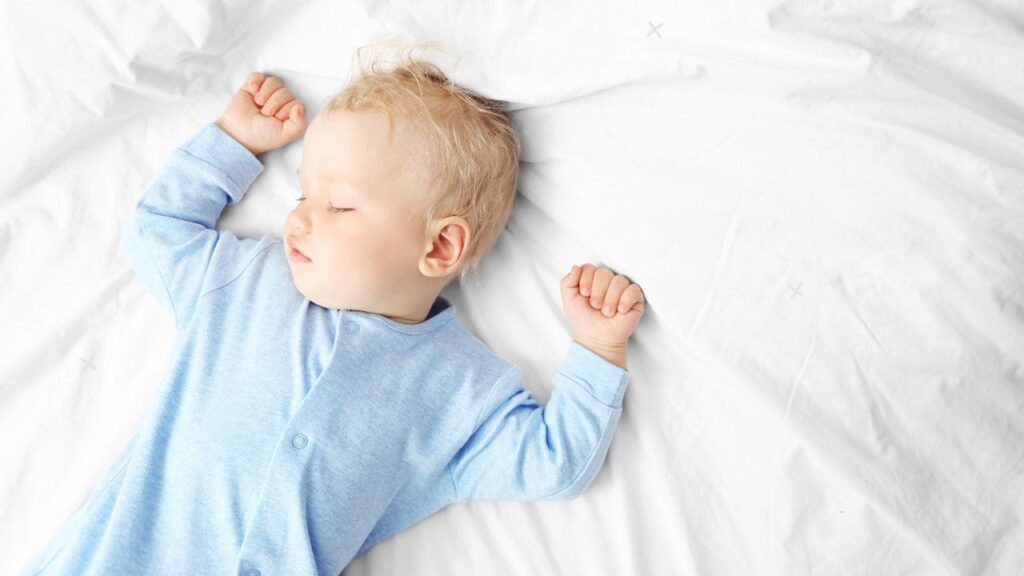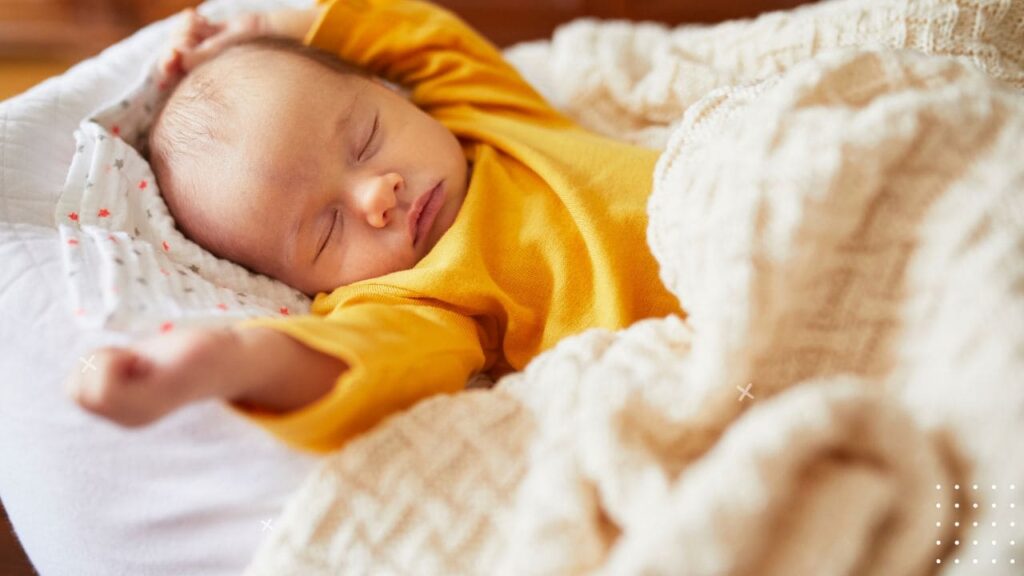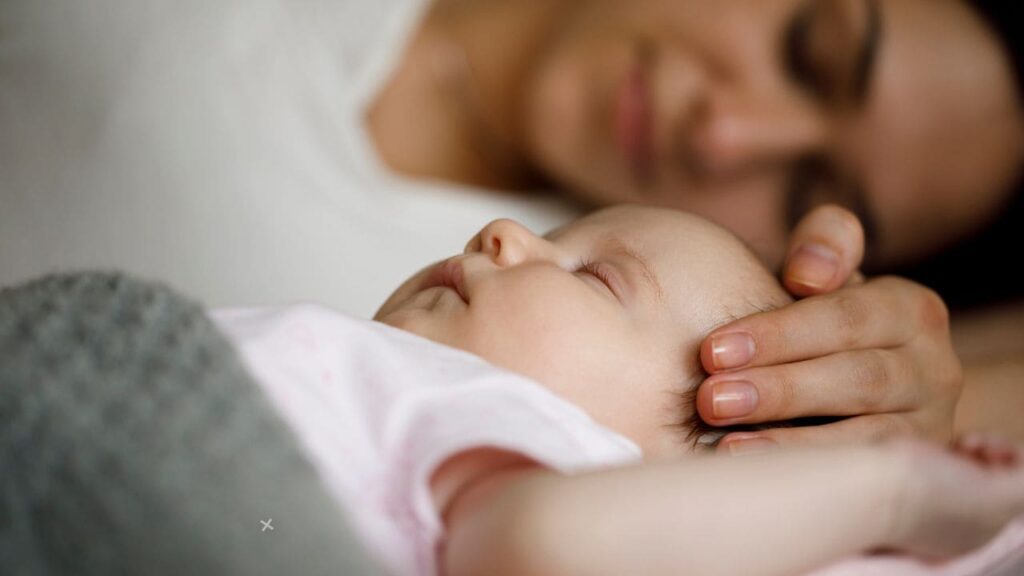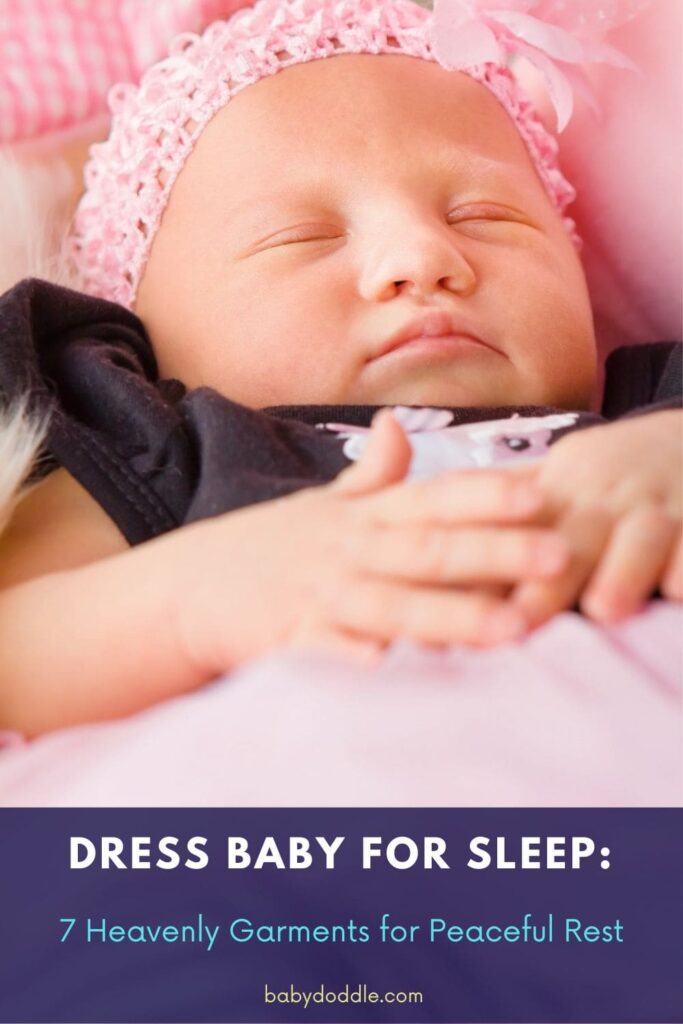As a new parent, one of the most significant challenges you’ll face is ensuring your little one gets the restful sleep they need for healthy growth and development. While there are many factors that can impact a baby’s sleep quality, dressing them appropriately for bedtime plays a crucial role in their comfort and safety. In this comprehensive guide, we’ll explore the importance of understanding your baby’s sleep needs, the benefits of breathable fabrics, and the seven heavenly garments that can help create a cozy and secure sleep environment.

Understanding Baby’s Sleep Needs and the Importance of Proper Sleepwear
Babies have unique sleep requirements that change as they grow and develop. During the first few months, newborns can sleep up to 16 hours a day, with their sleep cycles consisting of shorter periods of deep sleep and more frequent awakenings. As they grow older, their sleep patterns become more consolidated, with longer stretches of uninterrupted sleep.
Quality sleep is essential for a baby’s physical and cognitive development. It plays a crucial role in supporting their growth, brain development, and overall well-being. Proper sleep also helps regulate the body’s internal processes, such as hormone production, immune function, and metabolism.
One factor that can significantly impact a baby’s sleep quality is the sleepwear they’re dressed in. Uncomfortable or ill-fitting clothing can cause discomfort, overheating, or even pose safety risks, all of which can disrupt their sleep. That’s why it’s essential to choose the right sleepwear for your little one, taking into account factors such as breathability, comfort, and temperature regulation.
The Importance of Breathable and Comfortable Fabrics
When it comes to baby sleepwear, the fabric plays a crucial role in ensuring your little one’s comfort and safety. Babies have delicate skin that is more sensitive to irritation and discomfort, which is why it’s essential to choose materials that are soft, gentle, and breathable.
Breathable fabrics, such as cotton or bamboo, are ideal for baby sleepwear because they allow air to circulate freely, helping to regulate your baby’s body temperature and prevent overheating or sweating. These fabrics also have moisture-wicking properties, which can help keep your baby’s skin dry and comfortable throughout the night.
In addition to breathability, the softness of the fabric is also essential for your baby’s comfort. Rough or scratchy materials can irritate their delicate skin, causing discomfort and potentially disrupting their sleep. Look for fabrics with a smooth, gentle texture that won’t cause any irritation or chafing.
What is the Best Temperature for Baby Sleep?
Maintaining the optimal temperature for your baby’s sleep environment is crucial for their comfort and safety. Experts recommend keeping the room temperature between 68°F and 72°F (20°C and 22.2°C) for a newborn. As your baby grows older, you can adjust the temperature slightly lower, around 65°F to 70°F (18.3°C to 21.1°C).
However, it’s important to note that every baby is different, and their temperature preferences may vary. It’s essential to observe your baby’s cues and adjust the room temperature and sleepwear accordingly. Signs that your baby may be too hot or too cold will be discussed in a later section.
To help regulate the temperature and ensure your baby’s comfort, dress them in lightweight, breathable layers that can be easily adjusted. This will allow you to add or remove layers as needed, without compromising their safety or disrupting their sleep.
| Room Temperature | Recommended Sleepwear |
|---|---|
| 61°F (16°C) or below | Footed sleeper and sleep sack/swaddle |
| 62°F – 67°F (17°C – 19°C) | Footed sleeper and lightweight sleep sack or swaddle |
| 68°F – 72°F (20°C – 22°C) | Footed sleeper or sleep gown |
| 73°F – 77°F (23°C – 25°C) | Lightweight sleeper or sleep gown |
| 78°F (26°C) or above | Lightweight cotton onesie or just a diaper |
The Seven Heavenly Sleepwear Options for Babies
When it comes to dressing your baby for sleep, you have several options to choose from. Each type of sleepwear has its unique features and benefits, making it suitable for different ages, seasons, and preferences. Here are seven heavenly garments to consider for your little one’s peaceful rest:
Sleep Sacks: A Cozy and Safe Alternative to Blankets
Sleep sacks, also known as wearable blankets, are a popular and safe choice for baby sleepwear. These versatile garments are designed to keep your baby warm and cozy without the risk of loose blankets potentially covering their face and posing a suffocation hazard.
Sleep sacks come in a variety of materials, thicknesses, and designs, making them suitable for different seasons and temperatures. They typically have arm openings and a zippered or snap closure, making it easy to dress and undress your baby. Some sleep sacks even have built-in swaddle features or adjustable shoulder snaps to accommodate your baby’s growth.
When choosing a sleep sack, consider the weight and material based on the room temperature and your baby’s preferences. Lightweight, breathable options are best for warmer weather, while heavier, fleece-lined sacks may be more suitable for colder months.
Footed Pajamas: Keeping Tiny Toes Toasty
Footed pajamas are a classic and adorable option for baby sleepwear. These one-piece garments cover your baby’s entire body, including their feet, providing warmth and preventing them from kicking off blankets or covers during the night.
One of the main advantages of footed pajamas is their convenience. They’re easy to put on and take off, making diaper changes and middle-of-the-night outfit adjustments a breeze. They also come in a variety of fabrics, from lightweight cotton to cozy fleece, allowing you to choose the right material for the season or room temperature.
When selecting footed pajamas, pay attention to the fit. They should be snug but not too tight, allowing for comfortable movement and growth. Look for stretchy, breathable fabrics and consider zipper or snap closures for easy dressing and undressing.
Sleep Gowns: A Timeless and Convenient Choice
Sleep gowns, or nightgowns, are a traditional and practical option for baby sleepwear. These loose-fitting garments are designed to keep your baby comfortable while providing easy access for diaper changes and middle-of-the-night feedings.
Sleep gowns often feature simple designs with either snap or zipper closures down the front or back. They’re typically made from lightweight, breathable fabrics like cotton or bamboo, making them an excellent choice for warmer weather or climates.
One of the main benefits of sleep gowns is their versatility. They can be layered with other garments, such as onesies or sleepsuits, for added warmth during colder months. Additionally, their loose fit allows for easy movement and prevents any restriction or discomfort for your baby.
When choosing a sleep gown, consider the fabric weight and design. Look for gowns with built-in mittens or fold-over hand covers to prevent scratching, and opt for longer lengths to accommodate your baby’s growth.
Next-step advice: After reviewing these three popular sleepwear options, take some time to evaluate your baby’s individual needs and preferences, as well as the climate and room temperature in your home. Consider investing in a variety of sleepwear choices to ensure your little one is always comfortable and safe during their restful slumbers.

Two-Piece Pajama Sets: Mix and Match Comfort
Two-piece pajama sets offer versatility and flexibility when dressing your baby for sleep. These sets typically consist of a top and separate bottoms, allowing you to mix and match different weights and fabrics to suit the temperature and your baby’s preferences.
Tops can range from lightweight cotton tees to long-sleeved shirts, while bottoms may include cozy pants or shorts. This option is particularly useful during transitional seasons when you need to layer up or down based on fluctuating temperatures.
When choosing two-piece pajama sets, look for stretchy, breathable fabrics that allow for easy movement and growth. Consider investing in a few different weights and styles to accommodate various weather conditions and your baby’s changing needs.
Sleep Sack and Pajama Combinations: Layered Warmth
For cooler nights or during the colder months, you may want to consider combining sleep sacks with pajamas for extra warmth and coziness. This layered approach allows you to dress your baby in their regular sleepwear and then add the sleep sack as an additional layer.
Sleep sacks designed for layering often have wider openings or zippers that accommodate the addition of pajamas underneath. This combination not only provides extra insulation but also allows for easy diaper changes without disrupting the layers too much.
When choosing this option, ensure that the fabrics are breathable and that the overall layers don’t restrict your baby’s movement or cause them to overheat.
Sleeveless Sleep Rompers: Cool and Comfy
For warmer climates or during the summer months, sleeveless sleep rompers can be an excellent choice for keeping your baby cool and comfortable throughout the night. These one-piece garments are designed with short legs and no sleeves, allowing for better air circulation and temperature regulation.
Sleeveless sleep rompers are typically made from lightweight, breathable fabrics like cotton or bamboo, making them perfect for hot and humid conditions. They often feature snap or zipper closures for easy diaper changes, and some even have built-in mittens or fold-over hand covers to prevent scratching.
When selecting sleeveless sleep rompers, consider the fabric weight and choose lighter options for particularly warm weather. Also, ensure that the fit is snug but not restrictive, allowing for your baby’s natural movement and growth.
Wearable Blankets: Cozy and Safe Sleep Companions
Wearable blankets, similar to sleep sacks, are a safe and cozy alternative to traditional blankets for your baby’s sleep environment. These garments are designed to replace loose bedding, reducing the risk of entanglement or suffocation hazards.
Wearable blankets come in a variety of materials, from lightweight cotton to warm fleece or quilted fabrics, making them suitable for different seasons and temperatures. They typically feature arm openings and a zippered or snap closure, allowing for easy dressing and undressing.
When choosing a wearable blanket, consider the weight and material based on the room temperature and your baby’s preferences. Lightweight options are best for warmer weather, while heavier, insulated styles may be more appropriate for colder months.
By incorporating these additional sleepwear options, you now have a comprehensive list of seven heavenly garments to choose from when dressing your baby for a peaceful night’s rest.
Tips for Dressing Your Baby for Bedtime
Now that you’re familiar with the different types of sleepwear, let’s dive into some practical tips for dressing your baby for bedtime. These guidelines will help you ensure your little one’s comfort and safety throughout the night, promoting peaceful rest and healthy development.
What Should My Baby Wear to Sleep?
When it comes to dressing your baby for sleep, the general rule of thumb is to dress them in one more layer than you would wear in the same room temperature. This helps account for their smaller size and higher surface-area-to-body-mass ratio, which can cause them to lose body heat more quickly.
For example, if you’re comfortable in a lightweight shirt and pants, dress your baby in a onesie or sleeper, plus a lightweight swaddle or sleep sack. In cooler temperatures, you can add an extra layer, such as a lightweight blanket or sleep gown over their sleeper.
It’s important to note that every baby is different, and their temperature preferences may vary. Pay attention to your baby’s cues and adjust their sleepwear accordingly. If they seem too warm or too cold, remove or add layers as needed.

Signs Your Baby is Too Hot or Cold While Sleeping
Knowing how to identify if your baby is too hot or too cold while sleeping is crucial for their comfort and safety. Here are some signs to watch out for:
Signs of being too hot:
- Sweating, especially on the head or neck area
- Flushed or red skin
- Rapid breathing or panting
- Restlessness or irritability
Signs of being too cold:
- Cold hands and feet
- Pale or blotchy skin
- Shivering or trembling
- Crying or fussing
If you notice any of these signs, adjust your baby’s sleepwear and room temperature accordingly. Remove or add layers as needed, and ensure proper ventilation in the room to maintain a comfortable environment.
Next-step advice: Invest in a reliable room thermometer and make it a habit to check the temperature before putting your baby down for sleep. Adjust their sleepwear based on the temperature and your observations of their comfort levels. Don’t hesitate to make adjustments throughout the night if needed.
Safe Sleeping Practices: Reducing the Risk of SIDS
While choosing the right sleepwear is important for your baby’s comfort and rest, it’s equally crucial to follow safe sleeping practices to reduce the risk of Sudden Infant Death Syndrome (SIDS). SIDS is the leading cause of death among infants between 1 month and 1 year of age, and following expert recommendations can significantly lower the risk.
According to the American Academy of Pediatrics (AAP), the safest sleep environment for babies includes:
- Back sleeping for safety: Babies should always be placed on their backs to sleep, as this position has been shown to significantly reduce the risk of SIDS.
- Room sharing until at least 6 months old: Keeping your baby’s sleep area in the same room as you, but on a separate surface, is recommended for at least the first 6 months and ideally until their first birthday.
- Firm and flat sleep surfaces: Your baby should sleep on a firm, flat surface, such as a mattress in a safety-approved crib or bassinet. Avoid soft bedding, pillows, or other loose items in the sleep area.
- Removal of blankets and soft objects: Loose bedding, pillows, stuffed animals, and other soft objects should be removed from the sleeping area to prevent suffocation or entrapment hazards.
- Crib construction standards: Ensure your baby’s crib meets current safety standards and is free from potential entrapment hazards, such as loose or broken hardware or cutout designs in the headboard or footboard.
- Use of pacifier before sleep: Offering a pacifier at naptime and bedtime can reduce the risk of SIDS, but it should never be forced or reinserted once your baby is asleep.
- Avoiding bottles in bed: Never put your baby to bed with a bottle, as this can increase the risk of ear infections, tooth decay, and suffocation.
- Providing tummy time during the day: While back sleeping is recommended at night, it’s essential to provide supervised tummy time during the day to promote healthy muscle development and prevent flat spots on your baby’s head.
By following these safe sleep guidelines, you can create a secure and nurturing environment for your little one, allowing them to rest peacefully while reducing the risk of SIDS and other sleep-related injuries or hazards.
| Safe Sleep Practice | Check |
|---|---|
| Back sleeping position | ☐ |
| Firm, flat sleep surface | ☐ |
| No loose bedding or soft objects | ☐ |
| Room sharing until 6 months or older | ☐ |
| Safety-approved crib or bassinet | ☐ |
| Pacifier offered before sleep | ☐ |
| No bottles in bed | ☐ |
| Tummy time during the day | ☐ |
Should Newborns Wear Hats to Sleep?
One common question many new parents have is whether newborns should wear hats while sleeping. The short answer is no, healthy newborns do not need to wear hats to sleep.
Newborns have a higher surface-area-to-body-mass ratio, which means they lose body heat more quickly than older babies and adults. However, this is not a concern when they’re sleeping in a properly heated environment and dressed in appropriate sleepwear.
Experts recommend avoiding hats during sleep, as they can cause overheating and increase the risk of SIDS. Hats are primarily intended for outdoor use or in cooler environments to prevent heat loss through the head.
If you’re concerned about your newborn feeling too cold during sleep, it’s better to dress them in an extra layer of lightweight clothing or use a sleep sack or swaddle instead of a hat.
Are Baby Monitor Temperatures Accurate?
Many modern baby monitors come equipped with temperature sensors that display the room temperature of the parent unit. While these can be helpful indicators, it’s important to note that the accuracy of these readings may vary.
Baby monitor temperature sensors are typically placed near the baby’s sleep area, which means they may not accurately reflect the temperature in other parts of the room or account for drafts or localized heating sources.
Additionally, the placement of the sensor can affect its accuracy. If it’s too close to a wall or covered by bedding, the reading may not be representative of the overall room temperature.
While baby monitor temperature readings can provide a general idea of the room’s warmth, it’s best to rely on a separate, high-quality room thermometer placed at an appropriate distance from your baby’s sleep area. This will give you a more accurate reading to help you dress your baby appropriately for the ambient temperature.
Next-step advice: If you’re unsure about the accuracy of your baby monitor’s temperature reading, invest in a reliable room thermometer and place it at an appropriate distance from your baby’s sleep area. Check the thermometer regularly and adjust your baby’s sleepwear based on the accurate temperature reading, rather than solely relying on the monitor’s sensor.
Conclusion
Through this comprehensive guide, you now have a wealth of knowledge about dressing your baby for sleep, including the importance of breathable fabrics, temperature regulation, safe sleeping practices, and the seven heavenly garments that can promote peaceful rest. Remember, every baby is unique, and it may take some trial and error to find the perfect combination of sleepwear and techniques that work best for your little one.
Continuous observation and adjustment are key to ensuring your baby’s comfort and safety throughout the night. Don’t hesitate to consult with your pediatrician or a certified sleep consultant if you have any concerns or need personalized guidance.
FAQ – Dress Baby for Sleep
How do I know if my baby is too hot or too cold while sleeping?
Signs that your baby may be too hot include sweating, flushed skin, rapid breathing, and restlessness or irritability. If your baby feels hot to the touch, especially around the neck or head area, it’s a clear indication that they are overheating.
On the other hand, signs of being too cold include cold hands and feet, pale or blotchy skin, shivering or trembling, and crying or fussing. If your baby’s hands or feet feel cool to the touch, or if they seem particularly fussy or unsettled, they may need an additional layer of clothing.
It’s crucial to monitor your baby’s cues and adjust their sleepwear and room temperature accordingly. Remember, every baby is different, and their temperature preferences may vary.
Can I dress my baby in regular clothes for sleep, or do I need specific sleepwear?
While regular clothing can be used for sleep in some cases, it’s generally recommended to dress your baby in dedicated sleepwear. Sleepwear garments are designed specifically for sleep, with features that promote comfort, safety, and temperature regulation.
For example, sleep sacks and wearable blankets are safer alternatives to loose blankets, reducing the risk of suffocation or entanglement. Footed pajamas and sleep gowns are also designed for easy diaper changes and movement during sleep.
Sleepwear fabrics are typically lightweight, breathable, and soft, ensuring your baby stays comfortable throughout the night. Regular clothing may not offer the same level of comfort or safety for extended periods of sleep.
How often should I change my baby’s sleepwear?
It’s generally recommended to change your baby’s sleepwear every 1-2 days, or more frequently if it becomes soiled or damp. Babies can sweat or have diaper leaks during the night, making their sleepwear damp and uncomfortable.
Additionally, as your baby grows, their sleepwear may become too snug or too loose, affecting their comfort and safety. It’s a good idea to check the fit regularly and replace sleepwear as needed to accommodate their growth.
Remember to follow the care instructions for each garment, as some sleepwear may require special washing or drying instructions to maintain the fabric’s quality and breathability.
Is it safe to swaddle my baby for sleep?
Swaddling can be a safe and effective way to promote better sleep for newborns, as it mimics the cozy and secure feeling of the womb. However, it’s crucial to follow proper techniques and guidelines to ensure your baby’s safety.
The swaddle should be snug but not too tight, allowing for hip and chest movement. It’s also essential to stop swaddling once your baby shows signs of attempting to roll over, usually around 2-3 months of age, to reduce the risk of entrapment or suffocation.
If you choose to swaddle your baby, ensure you’re using a lightweight, breathable blanket, and that your baby’s face and head remain uncovered. Additionally, consider transitioning to a sleep sack or wearable blanket once your baby starts rolling over, as these provide warmth and security without the risks associated with loose blankets.
Can I use sleep sacks or wearable blankets for newborns?
Yes, sleep sacks and wearable blankets can be safe and comfortable options for newborns, provided you choose the appropriate size and weight for their age and the room temperature.
Many sleep sack and wearable blanket brands offer sizes specifically designed for newborns, with adjustable openings or snaps to accommodate their smaller size and allow for easy diaper changes.
When using these garments for newborns, it’s essential to follow safe sleep guidelines, such as ensuring a firm, flat sleep surface and avoiding loose bedding or soft objects in the sleep area. Additionally, pay close attention to your newborn’s cues to ensure they are not overheating or becoming too cold.
If you have any concerns or questions about using sleep sacks or wearable blankets for your newborn, consult with your pediatrician or a certified sleep consultant for personalized guidance.












